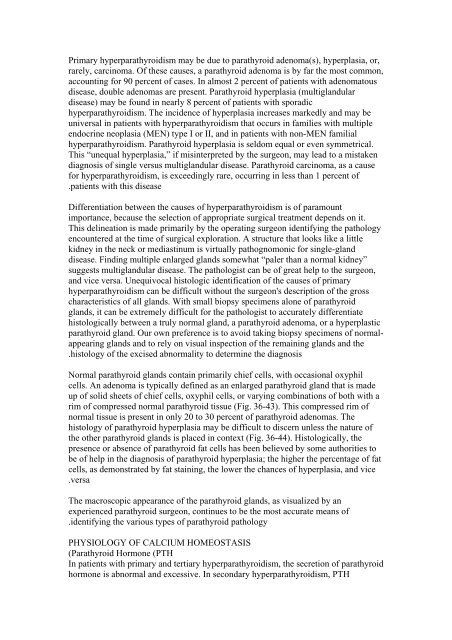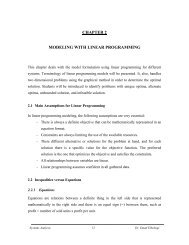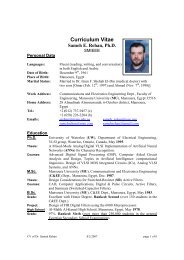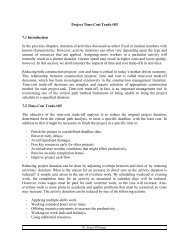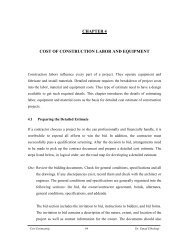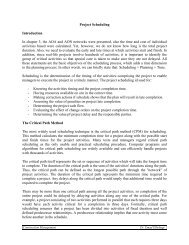Thyroid and Parathyroid
Thyroid and Parathyroid
Thyroid and Parathyroid
You also want an ePaper? Increase the reach of your titles
YUMPU automatically turns print PDFs into web optimized ePapers that Google loves.
Primary hyperparathyroidism may be due to parathyroid adenoma(s), hyperplasia, or,<br />
rarely, carcinoma. Of these causes, a parathyroid adenoma is by far the most common,<br />
accounting for 90 percent of cases. In almost 2 percent of patients with adenomatous<br />
disease, double adenomas are present. <strong>Parathyroid</strong> hyperplasia (multigl<strong>and</strong>ular<br />
disease) may be found in nearly 8 percent of patients with sporadic<br />
hyperparathyroidism. The incidence of hyperplasia increases markedly <strong>and</strong> may be<br />
universal in patients with hyperparathyroidism that occurs in families with multiple<br />
endocrine neoplasia (MEN) type I or II, <strong>and</strong> in patients with non-MEN familial<br />
hyperparathyroidism. <strong>Parathyroid</strong> hyperplasia is seldom equal or even symmetrical.<br />
This “unequal hyperplasia,” if misinterpreted by the surgeon, may lead to a mistaken<br />
diagnosis of single versus multigl<strong>and</strong>ular disease. <strong>Parathyroid</strong> carcinoma, as a cause<br />
for hyperparathyroidism, is exceedingly rare, occurring in less than 1 percent of<br />
. patients with this disease<br />
Differentiation between the causes of hyperparathyroidism is of paramount<br />
importance, because the selection of appropriate surgical treatment depends on it.<br />
This delineation is made primarily by the operating surgeon identifying the pathology<br />
encountered at the time of surgical exploration. A structure that looks like a little<br />
kidney in the neck or mediastinum is virtually pathognomonic for single-gl<strong>and</strong><br />
disease. Finding multiple enlarged gl<strong>and</strong>s somewhat “paler than a normal kidney”<br />
suggests multigl<strong>and</strong>ular disease. The pathologist can be of great help to the surgeon,<br />
<strong>and</strong> vice versa. Unequivocal histologic identification of the causes of primary<br />
hyperparathyroidism can be difficult without the surgeon's description of the gross<br />
characteristics of all gl<strong>and</strong>s. With small biopsy specimens alone of parathyroid<br />
gl<strong>and</strong>s, it can be extremely difficult for the pathologist to accurately differentiate<br />
histologically between a truly normal gl<strong>and</strong>, a parathyroid adenoma, or a hyperplastic<br />
parathyroid gl<strong>and</strong>. Our own preference is to avoid taking biopsy specimens of normalappearing<br />
gl<strong>and</strong>s <strong>and</strong> to rely on visual inspection of the remaining gl<strong>and</strong>s <strong>and</strong> the<br />
. histology of the excised abnormality to determine the diagnosis<br />
Normal parathyroid gl<strong>and</strong>s contain primarily chief cells, with occasional oxyphil<br />
cells. An adenoma is typically defined as an enlarged parathyroid gl<strong>and</strong> that is made<br />
up of solid sheets of chief cells, oxyphil cells, or varying combinations of both with a<br />
rim of compressed normal parathyroid tissue (Fig. 36-43). This compressed rim of<br />
normal tissue is present in only 20 to 30 percent of parathyroid adenomas. The<br />
histology of parathyroid hyperplasia may be difficult to discern unless the nature of<br />
the other parathyroid gl<strong>and</strong>s is placed in context (Fig. 36-44). Histologically, the<br />
presence or absence of parathyroid fat cells has been believed by some authorities to<br />
be of help in the diagnosis of parathyroid hyperplasia; the higher the percentage of fat<br />
cells, as demonstrated by fat staining, the lower the chances of hyperplasia, <strong>and</strong> vice<br />
. versa<br />
The macroscopic appearance of the parathyroid gl<strong>and</strong>s, as visualized by an<br />
experienced parathyroid surgeon, continues to be the most accurate means of<br />
. identifying the various types of parathyroid pathology<br />
PHYSIOLOGY OF CALCIUM HOMEOSTASIS<br />
( <strong>Parathyroid</strong> Hormone (PTH<br />
In patients with primary <strong>and</strong> tertiary hyperparathyroidism, the secretion of parathyroid<br />
hormone is abnormal <strong>and</strong> excessive. In secondary hyperparathyroidism, PTH


